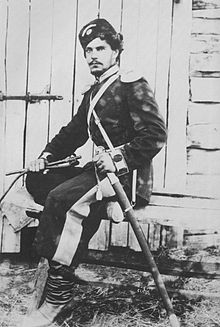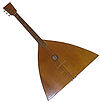- Shashka
-
Part of a series on Cossacks 
Cossack hosts Azov · Black Sea · Buh · Caucasus · Danube · Don · Volga · Ural · Terek · Kuban · Orenburg · Astrakhan · Siberian · Baikal · Amur · Semirechye · Ussuri · Zaporozhia Other groups Danube (Sich) · Tatar Cossacks · Nekrasov · Turkey · Jewish Cossacks History Registered Cossacks · Kosiński Uprising · Nalyvaiko Uprising · Khmelnytsky Uprising · Hadiach Treaty · Hetmanate · Colonisation of Siberia · Bulavin Rebellion · Pugachev's Rebellion · 1st Cavalry Army · Decossackization · Betrayal · XV SS Cossack Cavalry Corps · 1st Cossack Division Famous Cossacks Bohdan Khmelnytsky · Petro Sahaidachny · Ivan Vyhovsky · Petro Doroshenko · Ivan Mazepa · Ivan Sirko · Yemelyan Pugachev · Stenka Razin · Yermak Timofeyevich Cossack terms Ataman · Hetman · Kontusz · Papakhi · Plastun · Szabla · Shashka · Stanitsa · Yesaul The Shashka (Adyghe: (Сашьхъуэ),Russian: (Шашка)) is a special kind of sabre; a very sharp, single-edged, single-handed, and guardless sword. In appearance, the shashka was midway between a full sabre and a straight sword. It had a slightly curved blade, and could be effective for both slashing and thrusting. The blade was either hollowed or fullered. There was no guard, but a large, curved pommel. The hilt was frequently highly decorated. It was carried in a wooden scabbard that enclosed part of the hilt. It was worn with the cutting edge to the rear, opposite to the sabre.
History
The shashka originated among the mountain tribes of the Caucasus in the 12th or 13th century.[1] Later it was used by most of the Russian and Ukrainian[citation needed] Cossacks. So there are two styles of shashka: the Caucasian shashka and the Cossack shashka.
It was a typically Adyghean (Circassian) form of sabre, longer than the Cossack type, in fact the word shashka came from the Adyghe word Adyghe: ( Шашькуэ) "Shashkwa" means "long knife". It gradually replaced the sabre in all cavalry units except hussars during the 19th century. Russian troops, having encountered it during their conquest of the Caucasus, preferred it to their issue sabres. It was adopted first by the Russian Caucasian Corps in the 1830s. In 1882, when the cavalry was reorganized, the regular dragoons were armed with the shashka. Cossacks had received this type of sword earlier. Several forms of shashka were carried by Soviet cavalry into the Second World War.
Construction
 A Cossack from Orenburg, with a shashka at his side
A Cossack from Orenburg, with a shashka at his side
The absence of the guard is inherited from the original Caucasian construction, in which the shashka is nearly completely hidden in the scabbard, together with the hilt. The hilt is slightly curved down, thus providing an additional leverage for pulling the shashka and for additional force by wrist action.
The handle of the sabre was crafted so as to have a built-in pommel and possibly a small guard, which usually extended to only one side of the hilt. Like most medieval and then imperial Russian weaponry of the time, often the shashka and its scabbard were very ornately decorated, with gold and silver engravings, embedded gems and stones placed into, and figures carved out of or into, the hilts[citation needed]. The blade of the sabre was generally double or triple-fullered[citation needed], and due to its greater width than that of the European sabre[citation needed], and its unique styles of tempering,[citation needed] it was much stronger too[citation needed], able to deal damage to light body armor.[citation needed]
The shashka has the feel of a European sabre and was notable for its sharpness. There has been film footage of Tsar Nicholas II (1868–1918) using a Circassian sabre in an overhead twirling motion to horizontally cut pieces from a wooden pole.[citation needed]
References
- ^ The culture and customs of Adygs at the site www.adigeya.com (Russian) (caution: suspected malware site)
Russian souvenirs, arts and crafts 

Handicrafts 

Tableware - Table-glass
- Podstakannik
- Russian porcelain
- Samovar
Clothing Musical
instruments- Balalaika
- Garmon
- Russian guitar
- Musical spoons
- Treshchotka
Toys - Bird of Happiness
- Cheburashka
- Dymkovo toys
- Kargopol toys
- Matryoshka doll
- Petrushka
Other - Fabergé egg
- Shashka
- Tula gingerbread
- Vodka
Categories:- Sabres
- Military organization of Cossacks
- Weapons of Russia
- Russian loanwords
Wikimedia Foundation. 2010.


